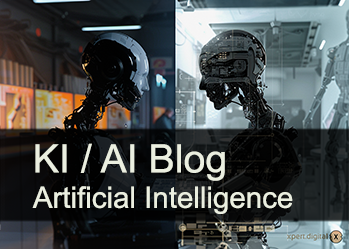Leaked internal Amazon strategy documents: The end of 600,000 jobs due to autonomous mobile robots?
Xpert pre-release
Language selection 📢
Published on: October 22, 2025 / Updated on: October 22, 2025 – Author: Konrad Wolfenstein

Leaked internal Amazon strategy documents: Could autonomous mobile robots mean the end of 600,000 jobs? – Creative image: Xpert.Digital
The automation wave at Amazon: When the largest employer becomes the biggest job destroyer
Amazon's calculated transformation
The leaked internal strategy documents of the world's largest online retailer read like a sober business plan, but their scope is epochal. According to information obtained by the New York Times, Amazon is planning an automation offensive that could eliminate over 600,000 jobs in the US by 2033. This isn't a gradual adaptation to technological changes, but rather a fundamental reorientation of the world of work in the low-wage sector. The figures are clear: By 2027, 160,000 new hires are to be avoided, while simultaneously 75 percent of all operational processes are to be automated. The company estimates savings of $12.6 billion within just two years – a cost reduction of approximately 30 cents per shipped item.
This automation strategy is no longer a theoretical vision of the future. Amazon already operates over a million robots in its more than 300 fulfillment centers worldwide—a number that is dangerously close to its current workforce of around 1.5 million. The newly developed AI system DeepFleet coordinates these robot fleets like an intelligent traffic management system and ensures that 75 percent of all Amazon deliveries are now assisted by robots. From heavy-duty transport robots like Hercules, which can move up to 570 kilograms, to autonomous units like Proteus, to highly specialized robot arms like Sparrow and Cardinal—the range of technologies deployed demonstrates the company's determination.
The planned communications strategy is particularly revealing: According to the leaked documents, Amazon is considering replacing terms like automation or artificial intelligence with more neutral expressions like advanced technology or cobots in order to defuse potential public opposition. This semantic camouflage reveals more about the expected social tensions than any business forecast. The company itself rejects the statements as incomplete, emphasizing that the documents do not reflect its entire human resources strategy. However, the sheer consistency of the data from various sources, as well as the developments already visible in its warehouses, tell a different story.
Suitable for:
The economic rationality of displacement
The economic logic behind Amazon's drive for automation is compelling. Studies on the economic viability of autonomous mobile robots and driverless transport systems show that investments in warehouse automation can pay for themselves in just one to two years – assuming a three-shift operation. The direct savings from reduced personnel costs are only part of the equation. Automated systems operate with a precision that can reduce material damage by up to 60 percent, optimize routes, and minimize downtime through continuous operation. In Germany, where the average hourly wage in the logistics industry is €33.50 and the tax burden on low wages is 43.9 percent, automation appears to be virtually unavoidable from a business perspective.
The global market for logistics robots impressively illustrates this development. It is forecast to grow from $6.41 billion in 2024 to $20.5 billion by 2032 – a compound annual growth rate of 16.7 percent. In 2023 alone, almost 113,000 service robots for transport and logistics tasks were sold worldwide, with mobile robots recording a 24 percent increase in sales. These figures illustrate that Amazon is by no means an isolated case, but merely the most visible protagonist of an industry-wide transformation. In Germany, the robot density in industry reached 415 industrial robots per 10,000 employees in 2023 – the third-highest figure worldwide after South Korea and Singapore.
The development of humanoid robots marks the next evolutionary stage. Systems like Agility Robotics' Digit, which is already being tested in Amazon warehouses, can lift, transport, and precisely place loads of up to 16 kilograms. Unlike previous generations of warehouse robots, which relied on specially adapted infrastructure, humanoid robots integrate into existing work environments designed for humans. This feature makes them particularly cost-effective, as expensive modifications are eliminated. Tesla with its Optimus model, Figure AI with Figure 02, Boston Dynamics with Atlas – the list of developers is growing, and analysts at Goldman Sachs predict that the market for humanoid robots could exceed $150 billion by 2035.
The forgotten downside of efficiency
While Amazon sells its automation strategy as a necessary step forward that will create new, more skilled jobs in areas such as maintenance, engineering, and AI-supported process optimization, the empirical evidence paints a more nuanced picture. The company points out that over 700,000 employees have already been retrained for new roles. But this narrative obscures the fundamental asymmetry between the jobs lost and the newly created. The reality in Amazon's warehouses reveals a different story.
Investigations by the U.S. Senate Committee led by Senator Bernie Sanders revealed shocking figures regarding working conditions. During Prime Day week in 2019, the overall injury rate in American Amazon warehouses reached nearly 45 percent—nearly one in two workers sustained an injury. The rate of reportable injuries was over 10 percent, more than double the industry average of 5.5 injuries per 200,000 work hours. Internal recommendations to lower productivity rates to curb injuries were rejected by Amazon management. The company, it is alleged, accepts employee injuries as a calculated cost of doing business.
These figures take on an additional dimension in light of the automation plans. Robots aren't primarily replacing dangerous or stressful jobs—they're primarily replacing humans whose performance is already reaching its physical limits under extreme time pressure. The promised new jobs in maintenance and programming will never be able to compensate numerically for the displaced warehouse positions. One maintenance technician can manage hundreds of robots; hundreds of warehouse workers create one maintenance technician job. The mathematical inequality is obvious.
The historical context: Creative destruction or destructive disruption
The Austrian economist Joseph Schumpeter coined the term "creative destruction" as a core mechanism of capitalist development. His thesis states that economic progress must necessarily displace and destroy old structures so that new ones can emerge. This perspective is often used to relativize technological unemployment as a temporary phenomenon. Historical examples seem to support this view: The Industrial Revolution of the 18th and 19th centuries destroyed countless skilled trades but ultimately created a more prosperous society with more jobs in new sectors.
However, the current situation differs fundamentally from previous technological upheavals. The automation of routine tasks since the 1990s has already led to a polarization of the labor market, primarily affecting the middle class. While highly skilled analytical jobs and low-skilled services requiring physical presence and interpersonal interaction remained relatively protected, middle-skilled jobs disappeared. Accountants, administrative clerks, and skilled workers in industry faced technological substitution, making their routine-dominated activities replaceable by computer systems.
However, the current phase of automation through AI and robotics differs qualitatively from this routine-biased technological change. For the first time, non-routine manual tasks are also affected – precisely those jobs that were previously considered difficult to automate. Humanoid robots like Digit or Optimus can grasp, navigate, and adapt to changing environments. The traditional protective function of flexibility and situational adaptation is eroding. At the same time, the process is accelerating: While previous industrial revolutions spanned generations and allowed time for societal adjustments, the current transformation is taking place within a few years.
The Nobel Prize winner's warning
Daron Acemoglu, the 2024 Nobel Prize-winning economist, has been explicitly critical of Amazon's automation plans. His warning is unequivocal: If Amazon implements its strategy, one of the largest employers in the US could transform from a job creator to a job destroyer. This assessment carries weight, as Acemoglu's research on the importance of inclusive institutions for economic prosperity has shown that technological progress alone is no guarantee of societal progress.
Acemoglu's central thesis is that the way technological innovations are implemented is crucial in determining whether they benefit society as a whole or merely exacerbate existing inequalities. In Amazon's case, there's a risk of a signaling effect: If the company demonstrates that complete automation is economically superior, other companies will follow suit. The resulting domino effect could lead to a phenomenon that analysts at Goldman Sachs refer to as jobless growth—an economy that grows and is productive, but doesn't create jobs.
Empirical data from the US suggests that this process has already begun. Employment growth outside the healthcare sector has turned negative in recent months, while at the same time, gross domestic product has grown robustly. Studies by McKinsey forecast that between 39 and 73 million jobs could be lost in the US due to automation by 2030, primarily in manufacturing, transportation, administration, and logistics. The net effect is estimated to be negative: without effective retraining programs, 19 to 23 million jobs are threatened. Young technology workers, whose employment prospects have already deteriorated, are particularly affected.
🎯🎯🎯 Benefit from Xpert.Digital's extensive, five-fold expertise in a comprehensive service package | BD, R&D, XR, PR & Digital Visibility Optimization

Benefit from Xpert.Digital's extensive, fivefold expertise in a comprehensive service package | R&D, XR, PR & Digital Visibility Optimization - Image: Xpert.Digital
Xpert.Digital has in-depth knowledge of various industries. This allows us to develop tailor-made strategies that are tailored precisely to the requirements and challenges of your specific market segment. By continually analyzing market trends and following industry developments, we can act with foresight and offer innovative solutions. Through the combination of experience and knowledge, we generate added value and give our customers a decisive competitive advantage.
More about it here:
Amazon replaces hundreds of thousands: Who bears the social costs?
The American dimension: low wages and lack of security
The socioeconomic conditions in the United States significantly exacerbate the problem. Unlike in Germany, where only about 16 percent of the workforce has no vocational training, this figure in the United States is almost 46 percent. This discrepancy reflects fundamental differences in education systems and labor market structures. The American labor market is characterized by pronounced wage polarization: an excellently educated and well-paid top class contrasts with a poorly paid lower class comprising almost half of the workforce.
This structure has far-reaching consequences for the automation debate. While in-company training, even for low-skilled workers, has increased in Germany over the past 15 years, it has declined in the US over the same period. Companies in the low-wage American segment are no longer investing in the qualifications of their employees—a rational decision when these workers are already considered interchangeable or replaceable by machines. Automation in the low-wage sector has already led to massive job losses in the US, whereas in Germany, higher qualification levels and stronger institutional safeguards have so far maintained relative stability.
Amazon's working conditions exacerbate this dynamic. The lack of unionization at most of Amazon's American locations means that workers are largely at the mercy of the company's rationalization strategies. While the Amazon Labor Union's historic victory at the JFK8 fulfillment center in New York in 2022 was an important milestone, Amazon has consistently refused to negotiate since then. Internal conflicts are further weakening the union, while the company is funding multimillion-dollar anti-union campaigns. The power and information asymmetry between one of the world's most valuable companies and precariously employed warehouse workers could hardly be greater.
Suitable for:
The skills gap and the retraining dilemma
The idea that displaced warehouse workers could be retrained as AI developers or robotics specialists lacks any realistic basis. While experts rightly emphasize the need for retraining and further education in promising fields such as data science, artificial intelligence, and automation technology, the hurdles are immense. Retraining as a data scientist or AI developer usually requires a university degree or at least extensive prior knowledge of mathematics and programming. A 45-year-old warehouse worker without formal vocational training who has spent years sorting packages will only be able to complete this transformation in exceptional cases.
The World Economic Forum estimates that by 2025, around 85 million jobs will be displaced due to the shift in the division of labor between humans and machines, while 97 million new jobs could be created at the same time. However, this aggregated view obscures individual fates and regional dislocations. The new jobs are primarily being created in urban technology centers and require qualifications that require several years of training. The displaced jobs, on the other hand, are located in logistics centers in rural regions and are filled by people whose formal education is often based on a high school diploma or less.
Even with massive investments in continuing education programs, the timing dilemma remains. The World Economic Forum estimates that 40 percent of the core competencies of 50 percent of all workers will change in the next five years. The combination of automation and other disruptions has shrunk the window for adaptation to just a few years. However, substantial retraining often takes two to four years—time that many affected employees don't have given economic constraints. The discrepancy between the speed of technological change and the inertia of human learning processes represents a fundamental challenge for which no convincing solutions exist to date.
Systemic fragility and social tensions
The macroeconomic implications of Amazon's automation strategy extend far beyond the jobs directly affected. When one of the largest private employers in the US systematically eliminates low-wage jobs without creating equivalent alternatives, cascading effects occur. The purchasing power of millions of households declines, dampening consumer demand—the very foundation upon which Amazon's own business model is built. This inherent contradiction was already recognized in the 1920s by Henry Ford, who paid his workers above-average wages so they could afford his cars.
The fiscal consequences are also significant. Unemployed or underemployed former warehouse workers no longer pay income taxes and social security contributions, but at the same time place a greater burden on social security systems. In the US, where the social safety net is already full of holes, this threatens to exacerbate already pronounced inequality. Data show that in 2014, one percent of the world's population owned over 48 percent of global wealth. Automation threatens to further exacerbate this concentration, as productivity gains primarily accrue to capital owners, while labor incomes erode.
Political instability is a likely consequence of this development. Historically, technological upheavals that deprived large segments of the population of their livelihoods have always been accompanied by social unrest. The Luddite movement of the early 19th century, the labor unrest of industrialization, the protests against globalization and outsourcing – all these phenomena reflect resistance to changes perceived as threatening and unjust. The current popularity of populist movements in the US and Europe is fed not least by the diffuse fear of economic decline that large segments of the population are already experiencing or anticipating.
Amazon's communicative strategy of romanticizing automation as advanced technology and avoiding the term "artificial intelligence" demonstrates an awareness of these tensions. But semantic obfuscation won't change the material realities. When hundreds of thousands of people lose their jobs while stock prices rise and corporate profits reach new records, the social legitimacy of such a system is fundamentally questioned.
Alternatives and regulatory options
The question isn't whether automation will happen—it's already a reality and will continue. The crucial question is how it will be designed and who will bear its costs and benefits. Various regulatory approaches are conceivable to mitigate the negative consequences and achieve a more inclusive distribution of productivity gains.
A robot tax, as proposed by Bill Gates and others, could not prevent automation, but it could moderate its pace and generate revenue to finance retraining programs and social security. The basic idea is that companies pay a levy for each human job replaced, equivalent to the lost income tax and social security contributions. Critics argue that such a tax would stifle innovation and jeopardize international competitiveness. Proponents counter that the long-term social costs of uncontrolled automation outweigh short-term competitive disadvantages.
Reducing working hours with full compensation is another option that has been successfully used in the past to manage productivity increases. If robots take over some of the work, the remaining human labor could be distributed among more shoulders, so everyone works less but still earns a living. Historically, reducing working hours has been a key mechanism for distributing the productivity gains of industrialization: The 40-hour workweek was unthinkable in the 19th century but is standard today. A further reduction to 30 or 25 hours could have a similar effect.
An unconditional basic income is being discussed as a more radical solution. If human labor is increasingly replaced by machines, a basic income decoupled from earned income could ensure material security. It would be financed by taxing corporate profits and assets resulting from automation. Critics warn of problems with work incentives and fiscal unsustainability. However, pilot projects in various countries have shown that many people continue to work despite a basic income, albeit often in more self-determined and creative activities.
Stronger employee rights and co-determination could also play a role. In Germany, the co-determination system prevents rationalization decisions from being made exclusively by capital. Works councils and unions influence the shaping of technological change. In the US, such structures are largely lacking, giving companies like Amazon enormous leeway. Strengthening union organization and statutory co-determination rights could at least ensure a more socially acceptable design of automation.
The Paradox of Progress
The current situation reveals a fundamental paradox: Humanity possesses technologies that could theoretically enable everyone to live a life of material prosperity while simultaneously reducing their workload. Robots and AI could take over the monotonous, dangerous, and stressful tasks, while humans devote themselves to more creative, fulfilling, and socially valuable tasks. But instead of realizing such a utopian vision, automation under current conditions threatens to plunge millions into unemployment and poverty, while a small elite monopolizes productivity gains.
In this context, Amazon's automation strategy is symptomatic of a broader systemic misdevelopment. The company operates rationally within existing incentive systems. Shareholders demand profit maximization, competitors focus on increased efficiency, and consumers expect low prices and fast delivery. Automation makes all of this possible. The fact that hundreds of thousands of jobs are being destroyed and social tensions are growing in the process appears from a business perspective to be external effects that are not factored into the calculation.
But externalities have the unpleasant habit of eventually becoming internalized—just not voluntarily. When social upheaval reaches a level that threatens political stability, governments will be forced to intervene. The question is whether this happens preventively and constructively or reactively and chaotically. History shows that technological upheavals that entail significant social costs have ultimately always provoked regulatory responses—from the Factory Act in Victorian England to Bismarck's social legislation to Franklin D. Roosevelt's New Deal programs.
A turning point for the world of work in the 21st century
Amazon's plan to replace 600,000 jobs with robots is more than a corporate decision. It's a precedent that could set the course for the world of work in the coming decades. If the largest private employer in the US demonstrates that complete automation in the low-wage sector is not only technically feasible but also economically superior, others will follow. The signaling effect is enormous.
The leaked internal documents reveal a strategy that recklessly exploits technological possibilities without adequately considering the social consequences. The planned communicative obfuscation through euphemisms like "advanced technology" shows that the company is certainly aware of the explosive nature of its plans. But awareness alone will not lead to behavioral changes as long as the economic incentives clearly point toward automation.
Daron Acemoglu's warning that Amazon could transform from a job creator into a job destroyer should be taken seriously. The Nobel laureate's research has shown that institutions and social conditions determine whether technological progress has an inclusive effect or exacerbates inequality. In Amazon's case, the institutional safeguards that would ensure socially acceptable automation are evidently lacking. The lack of unionization, weak worker rights, inadequate social security systems, and policies that prioritize corporate interests – all of this creates an environment in which the negative consequences of automation are maximized.
At the same time, it would be wrong to demonize technology or reject automation outright. History shows that technological progress cannot be stopped and has actually led to greater prosperity in the long run. But this prosperity was never distributed automatically and evenly. It had to be fought for, won, and shaped through wise policy. The challenge is to develop mechanisms that ensure that the productivity gains of automation are widely shared rather than concentrated in the hands of a few.
The coming years will show whether modern societies are capable of shaping this technological change or whether they will be shaped by it. Amazon's automation plans are a stress test for democratic systems, social market economies, and the idea that economic progress should benefit everyone. The outcome of this test is by no means predetermined. It depends on political decisions, social power relations, and the ability to reconcile short-term business rationality with long-term societal common sense. The leaked documents from Seattle are less a glimpse into an inevitable future than a warning of a possible future—and thus also a call to explore alternative paths.
Your global marketing and business development partner
☑️ Our business language is English or German
☑️ NEW: Correspondence in your national language!
I would be happy to serve you and my team as a personal advisor.
You can contact me by filling out the contact form or simply call me on +49 89 89 674 804 (Munich) . My email address is: wolfenstein ∂ xpert.digital
I'm looking forward to our joint project.
☑️ SME support in strategy, consulting, planning and implementation
☑️ Creation or realignment of the digital strategy and digitalization
☑️ Expansion and optimization of international sales processes
☑️ Global & Digital B2B trading platforms
☑️ Pioneer Business Development / Marketing / PR / Trade Fairs
Our US expertise in business development, sales and marketing
Industry focus: B2B, digitalization (from AI to XR), mechanical engineering, logistics, renewable energies and industry
More about it here:
A topic hub with insights and expertise:
- Knowledge platform on the global and regional economy, innovation and industry-specific trends
- Collection of analyses, impulses and background information from our focus areas
- A place for expertise and information on current developments in business and technology
- Topic hub for companies that want to learn about markets, digitalization and industry innovations


























